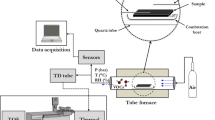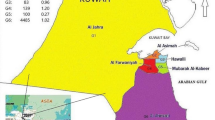Abstract
MODERN methods for sampling of organic vapours in air pollution studies avoid the problems caused by the condensation of water vapour, by collection at ambient temperature on charcoal1, porous polymers2–5 or support-bonded phases5. The tenacity of adsorption renders the sample difficult to remove and indirect methods such as liquid extraction1,5 or thermal desorption2–4 are necessary to produce a sample for gas chromatographic (GC) or GC–mass spectrometric analysis. We describe here an analytical technique based on the Curie point pyrolysis system6 which overcomes these problems by using ferromagnetic wires coated with a thin layer of highly active charcoal. These are simply suspended in the atmosphere under test for 1–2 h at room temperature, placed in the Curie point apparatus and then inductively heated in the normal manner. Thus the sample is rapidly introduced into the GC for direct analysis. The fact that the total amount of each hydrocarbon present is not adsorbed by this method is outweighed by the advantages of direct sample introduction, which offers distinct advantages to the forensic scientist in the investigation of a suspected arson. The technique could also find quantitative application in air pollution studies.
This is a preview of subscription content, access via your institution
Access options
Subscribe to this journal
Receive 51 print issues and online access
$199.00 per year
only $3.90 per issue
Buy this article
- Purchase on Springer Link
- Instant access to full article PDF
Prices may be subject to local taxes which are calculated during checkout
Similar content being viewed by others
References
Grob, K. & Grob, G. J. Chromat. 62, 1–13 (1971).
Dravnieks, A., Krotoszynski, B. K., Whitfield, J., O'Donnell, A. & Burgwald, T. Environ. Sci. Technol. 5, 1220–1222 (1971).
Perry, R. & Twibell, J. D. Atmos. Env. 7, 929–937 (1973).
Bertsch, W., Chang, R. C. & Zlatkis, A. J. chromatog. Sci. 12, 175–182 (1974).
Aue, W. A. & Teli, P. M. J. Chromat. 62, 15–27 (1971).
Simon, W. & Giacobbo, H. Angew. Chem. Intern. Ed. 4, 938–943 (1965).
Ettling, B. V. & Adams, M. F. J. Forensic Sci. 13, 76–89 (1968).
Lonneman, W. A., Bellar, T. A. & Altshuller, A. P. Environ. Sci. Technol. 2, 1019–1020 (1968).
Author information
Authors and Affiliations
Rights and permissions
About this article
Cite this article
TWIBELL, J., HOME, J. Novel method for direct analysis of hydrocarbons in crime investigation and air pollution studies. Nature 268, 711–713 (1977). https://doi.org/10.1038/268711a0
Received:
Accepted:
Issue Date:
DOI: https://doi.org/10.1038/268711a0
This article is cited by
Comments
By submitting a comment you agree to abide by our Terms and Community Guidelines. If you find something abusive or that does not comply with our terms or guidelines please flag it as inappropriate.



